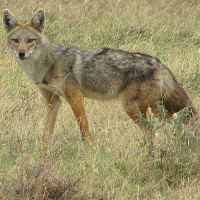 |
Golden Jackal |
|
He is a wild animal |
Origin |
Africa, Europe and Asia | |
Translation |
Francis Vandersteen |
| The possession of this animal is not authorized Royal Decree establishing the list of mammals not kept for production purposes that may be kept (M.B. 24.08.2009) |
| The Golden Jackal (Canis aureus) is a species of canid found in northern and eastern Africa (particularly Algeria and Tunisia), southeastern Europe, the Middle East and as far south as Burma and India. It reappeared in Hungary after having disappeared, and was also seen in Switzerland in autumn 2011, as well as in Graubünden in 2015. In early 2016, a golden jackal was accidentally shot in the Surselva region (Grisons, Switzerland). This was the first tangible evidence of the species' existence in Switzerland. It was also identified in spring 2013 on the island of Hiiumaa in Estonia in the Baltic Sea. It would have reached this vast island by crossing the pack ice. In September 2015, an individual killed on the road by a vehicle was identified in Jutland, Denmark. In France, an individual was photographed by an automatic trap in the Chablais region of Haute-Savoie at the end of 2017. Once widely present (according to paleontological fossil evidence), it is one of the world's most widespread canid species, with vast territories in central, eastern and southern Europe, North Africa and parts of Asia. It has survived in remote, often desert, areas, but is not a species uniquely adapted to warmer climates: it was common in the Paleolithic in the Caucasus, and like the hyena and genet (Genetta genetta) was contemporary with bison, aurochs, mammoths and other examples of the fauna contemporary with prehistoric man in France during the last interglacials. Since the Middle Ages, and especially in the modern period, its European distribution seems to have fluctuated widely, with spectacular declines until the 1960s, a period of recovery (1960s, 1970s) and then expansion, particularly towards north-western Europe (since the early 1980s). This is a social species, whose basic social unit is a breeding pair accompanied by its young. Highly opportunistic, the golden jackal is able to exploit a wide range of food resources, from fruit and insects to small ungulates. In Eastern Europe, a study concluded that its trophic niche was close to that of the fox; according to excrement analyses: small mammals (35% on the basis of frequency of occurrence and 36% on the basis of biomass) and corpses of wild boar, roe deer... (35% and 48%, respectively, based on the same parameters). In this study, no domestic or small game species (rabbit, deer) were consumed, nor were any fish. A few birds, reptiles, amphibians, arthropods and plant matter completed the diet, on the margins. Contrary to popular belief, this canid is loyal to its clan. Because it can travel for several days without eating or drinking, the golden jackal is adapted to arid environments and wide open spaces. The golden jackal is an excellent hunter and attacks in packs. Like the hyena, it is not simply a desert scavenger; light, agile and opportunistic, it combines the flair and speed of a hound with the cunning of a fox. Its most common technique is to pursue vulnerable prey (sick, old, wounded) to exhaustion, then bite its tendons to bring it down. The golden jackal then attacks and eviscerates the belly. Rodents are often its main source of food (e.g.: 45% of its total caloric intake in arid India), but it may exceptionally attack larger prey (young sheep or cows in Israel; often within two days of giving birth); if the prey is large, the pieces are scattered in hiding places that serve as larders. |






 English (United Kingdom)
English (United Kingdom)